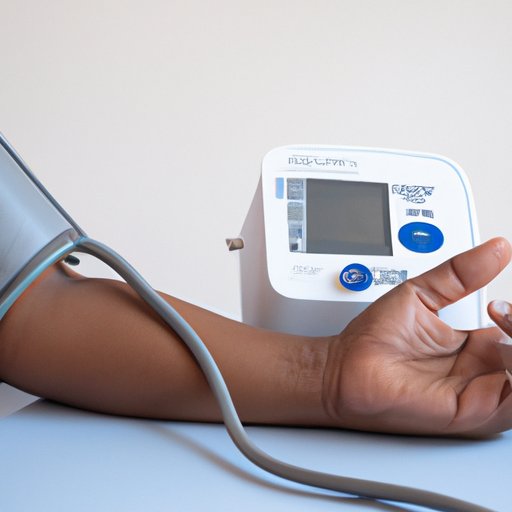
Introduction
High blood pressure, also known as hypertension, is a common health problem that affects millions of people worldwide. Many individuals turn to exercise as a way to maintain cardiovascular health and lower blood pressure. However, after exercise, some individuals may experience a noticeable rise in blood pressure. This article aims to delve into the science behind post-exercise blood pressure, the effects of exercise on hypertension, and ways to manage and prevent post-workout blood pressure spikes.
The Science Behind Post-Exercise Blood Pressure
During exercise, the body has a higher demand for oxygen, which requires the heart to pump more blood. An increase in heart rate and cardiac output results in temporary higher blood pressure levels during the workout. However, after the physical activity, the body will start to return to its normal state, and blood pressure should fall back to normal levels.
The exact reasons behind blood pressure rising after exercise are unclear. Some scientists theorize that it may be a result of increased adrenaline levels, dehydration, or oxidative stress. However, it is essential to understand that post-workout blood pressure can be influenced by various factors such as age, health status, type, and intensity of exercise, among others.
The Truth About Post-Exercise Blood Pressure and Hypertension
Studies show that regular exercise has a positive impact on hypertension and cardiovascular health. According to the American Heart Association, moderate-intensity exercise for 30 minutes most days of the week can lower blood pressure in individuals with hypertension by four to nine points. Physical activity can also reduce the risk of developing hypertension in people who were initially healthy.
However, in some cases, strenuous exercise may lead to temporary hypertension, or exercise-induced hypertension. This condition occurs mostly in individuals with high blood pressure or other pre-existing cardiovascular conditions. Unfortunately, exercise-induced hypertension has been linked to an increased risk of developing chronic hypertension in the long term.
It is crucial to note that the risk of developing chronic hypertension as a result of exercise-induced hypertension is relatively low. The benefits of exercising still outweigh the risks, and it is safe for most individuals to engage in physical activity.
How Exercise Affects Your Blood Pressure
Exercise has enormous benefits for maintaining cardiovascular health, including regulating blood pressure levels. Physical activity helps improve the efficiency of the heart and improves the health of blood vessels, reducing the risk of hypertension and other cardiovascular diseases. It can also help maintain a healthy weight and reduce stress levels, both of which play a critical role in blood pressure regulation.
It is worth noting that not all types of physical activity have the same effect on blood pressure. Aerobic exercise has the most significant impact on reducing blood pressure levels, particularly moderate-intensity activities like brisk walking, cycling, and swimming. Resistance training can also help lower hypertension, but it needs to be done in conjunction with at least moderate-intensity aerobic exercise.
Debunking the Myth: Why Exercise-Induced Hypertension is Not as Dangerous as You Think
As mentioned earlier, temporary hypertension after exercise is a relatively common occurrence, with exercise-induced hypertension being a more severe form of this condition. While exercise-induced hypertension can pose some risks, it is essential to differentiate it from chronic hypertension.
Chronic hypertension is a long-term medical condition that can lead to severe health complications such as heart disease, stroke, and kidney failure. Exercise-induced hypertension, on the other hand, is non-life-threatening, and the risk of it developing into chronic hypertension is minimal.
It is worth noting that if you have hypertension or other cardiovascular conditions, attending regular medical check-ups and following the advice of a healthcare professional is crucial when engaging in exercise to manage blood pressure levels safely.
Managing Post-Workout Blood Pressure
Suppose you are experiencing blood pressure spikes after exercising. In that case, several strategies can help prevent and manage this condition effectively. Firstly, it’s important to stay well hydrated before, during, and after physical activity to avoid dehydration, which can contribute to elevated blood pressure. Secondly, it’s best to engage in moderate-intensity workouts gradually to reduce the likelihood of developing exercise-induced hypertension. Additionally, incorporating activities like practicing yoga, meditation and deep breathing exercises post-workout can also help lower blood pressure levels.
It’s recommended to create a personalized exercise program in conjunction with the advice of your healthcare provider if you have hypertension or other pre-existing medical conditions. They can assist you in determining the best type and frequency of exercise to manage your blood pressure levels safely.
Conclusion
Overall, exercise has enormous benefits for maintaining cardiovascular health, regulating blood pressure levels, and reducing the risks of developing hypertension. While blood pressure may rise temporarily after physical activity, this is a normal part of the body’s physiological response, and the risks are minimal for most individuals. Staying hydrated, starting with moderate workouts, and incorporating relaxation practices can help manage and prevent post-workout blood pressure spikes. Consultation with a healthcare provider is recommended, particularly for individuals with pre-existing cardiovascular conditions.





